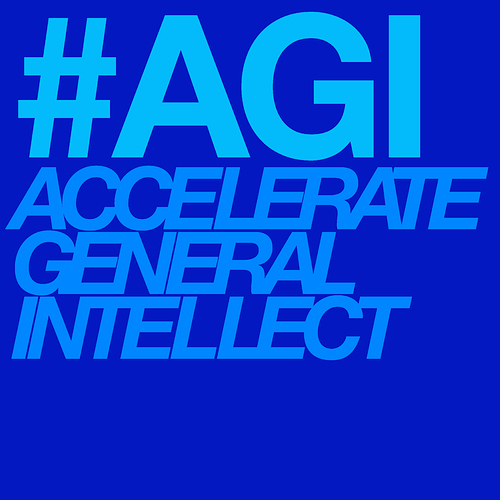IMPORTANT ANNOUNCEMENT FOR #AGI ROUNDTABLE ATTENDEES
For all those planning to attend the #AGI Accelerate General Intellect Plenary session at e-flux New York on Friday afternoon: due to unforeseen circumstances, we are cancelling this event. We will be hosting the conversation in an internal format in the near future, and further announcements will provide information for those interested as soon as it becomes available. We apologize for any inconvenience, and thank everyone for their continued interest in the #AGI residency.
////////////////////////////////////////////
The New Centre for Research & Practice is thrilled to announce its New York Summer Residency, entitled “#AGI Accelerate General Intellect.” The residency takes place July 18–22, 2016 at various venues around New York City. On July 20, we will host a panel during the Future of Mind Symposium as part of a collaboration with the New School’s Center for Transformative Media and Humanity+.
Please join us for a week of seminars, workshops, and panel discussions at Pratt Institute, The New School for Social Research, and e-flux, as our resident artists, thinkers, and writers speculate about the future implications of collective thought and cognition on philosophical, political, and technological developments. Many of the week’s events will be live-blogged here at e-flux conversations, starting Monday, July 18.
What does it mean to accelerate the general intellect in the age of artificial intelligence? #AGI begins from the investigation of distributed networks from which thought assembles and into which it disperses. Unlike in the past, general intelligence, algorithms, and networks are together becoming as irreducible to the efforts of “universal” intellectuals as cultural and political movements have become to “universal” leaders. Will the future enable a more radical, integrated, but also more complex mode of cultural and political engagement? One predicated upon what Marx describes as, “the conditions of the process of social life itself… under the control of the general intellect” (1).
#AGI explores the new intensifying developments in the field of AI that are making possible subjectless modes of the general intellect, more collective and more general than any single individual or network.
SCHEDULE
July 18 at Pratt Institute /// Moderated by Tony Yanick
09:00 – 09:30, Coffee
09:30 – 10:00, Introductory Remarks
10:00 – 12:00, Pete Wolfendale
12:00 – 13:00, Discussion
13:00 – 14:00, Lunch
14:00 – 14:30, Ahmed El Hady
14:30 – 15:00, Discussion
15:00 – 16:00, Katarina Kolozova /// Video Conference from Macedonia
16:00 – 16:30, Discussion
July 19 at Pratt Institute /// Moderated by Mohammad Salemy
09:00 – 09:30, Coffee
09:30 – 10:00, Introductory Remarks
10:00 – 11:00, Matteo Pasquinelli /// Video Conference from Berlin
11:00 – 11:30, Discussion
11:30 – 11:45, Break
11:45 – 12:30, Amy Ireland
12:30 – 13:00, Discussion
13:00 – 14:00, Lunch
14:00 – 15:00, Joshua Johnson & Keith Tilford
15:00 – 15:15, Break
15:15 – 17:00, Nick Land
17:00 – 18:00, Discussion
July 20th: Future of Mind at The New School (2)
15:30 – 16:45, The New Centre Panel Discussion with Reza Negarestani Patricia Reed, & Peter Wolfendale
July 21 at The New School /// Moderated by Jason Adams
09:00 – 09:30, Coffee
09:30 – 10:00, Introductory Remarks
10:00 – 11:00, Patricia Reed
11:00 – 11:30, Discussion
11:30 – 11:45, Break
11:45 – 14:30, Lunch
14:00 – 14:30, Eden Medina /// Video Link from Indiana
14:30 – 15:00, Discussion
15:00 – 15:15, Break
15:15 – 17:00, Reza Negarestani
17:00 – 18:00, Discussion
CANCELLED /////// July 22 at e-flux 18:00 – 21:30pm
Audio-acoustic intervention by Jason Brogan
Plenary session with Amy Ireland / Nick Land /Reza Negarestani / Patricia Reed / Pete Wolfendale /// Moderated by Jason Adams, Mohammad Salemy & Tony Yanick ////////
The Residency is free for The New Centre Friends and Members (to become a member, please visit: http://thenewcentre.org/membership/member/). General admission is by donation. Space for each location has specific limits, to secure seats please register for #AGI: https://docs.google.com/forms/d/1W-ocorcQ41Tv-isTZRuu6hKTEa-019FsurepjpdwADs/viewform
(1) Karl Marx, Grundrisse (London: Penguin Books, 1973), 706.
(2) Please visit the website for the Future of Mind conference (https://futureofmind.wordpress.com/) for information on registeration to attend this event separately.

